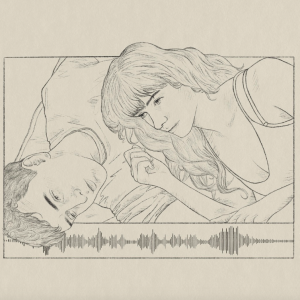
Bedtime Stories
by Margot Harvey | July 5, 2020
“Sometimes I think I deserve bad things because I’m a bad person,” a girl murmurs to an ex-boyfriend. She is digitised and sports beautiful bangs, a puzzle of pixels dancing across the nation’s laptop screens three weeks into lockdown. But the tragedy of it rings true: falling in love with the cruel and /or careless is a familiar form of self-harm. What Normal People’s Marianne was referring to, though, was her desire to be ‘beaten up’ in bed. Sally Rooney’s sex scenes took forty-one minutes of BBC’s airtime, but Normal People hardly offered a hot take on rough sex. Asking for abuse in bed is, we are told time and time again, the stuff of immense insecurity – or better yet, a disturbing tendency for people who have suffered immeasurable trauma.
This is exactly the stance mainstream media has historically taken on BDSM. Freud’s beliefs that sadomasochistic behaviour is pathological and invariably a result of childhood damage have been accepted as gospel. Often, the ‘sexual deviance’ described has been linked to the LGBT community – a tendency of a heteronormative and often hateful society. Nine years on from Fifty Shades bringing BDSM squarely into the mainstream, it remains clear that very little has been done to deconstruct the taboo.
Despite the increasingly liberal landscape of 21st century sex, pop culture creations are still on the back foot. Christian Grey and Marianne are self-diagnosed as “fifty shades of fucked up” and “unlovable” respectively, apparently a result of abuse in their formative years. The implication that sadomasochism and mental ill-health go hand in hand continues to permeate pop culture and psychoanalysis alike, despite being grounded in very little factual evidence. Mr. Grey’s almost verbatim regurgitation of Freud’s theory that desire for sadomasochistic sexual activity is something to be cured is as mythic as the idea that a doe-eyed lover can be the one to save you from it.
Criticism of the concept is unsurprising. A notion born in the context of dominant men naturally inclined to physical power over inherently submissive women (thank you Marquis de Sade) is easy for the 21st century feminist to debunk. The inescapable fact that the language of BDSM (master, bondage, punishment) is rooted in slavery does it no favours, but the notion that what we do in bed is our business is difficult to dismiss.
Nevertheless, puritanical anxiety is reflected in the ultimate decider of our collective moral compass: the law of the land. In 1993, the House of Lords, acting as the Supreme Court at the time, decided that what two consenting adults get up to in the privacy of their own bedroom does in fact require regulation. Depressingly, for the BDSM enthusiasts among us, they decided that sadomasochism is against the law when marks are left, regardless of whether the parties gave consent.
As it stands, if you ask me to punch you in the face and break your nose and I follow your instructions, I’ve committed actual bodily harm. I can go to prison for a maximum of five years. Consent is immaterial where one person brings harm to another. Of course, in certain contexts, we see things differently. We embrace contact sport and we encourage childhood horseplay. No issues are raised with tattoos and piercings, and cosmetic surgery involves a fair number of cuts and bruises. Forms of consensual harm occur all the time, citing self-expression and personal development, and we are collectively unbothered. The exception is sex.
Out of the House of Lords’ 1993 ruling comes Lord Templeman’s assertion “pleasure derived from the infliction of pain is an evil thing.” Lord Lowry goes further, instructing us not “to satisfy a perverted and depraved sexual desire.” Lord Jauncy of Tullichettle calls such activities “rather curious”, but remains steadfast in his stance that “deliberate infliction of actual bodily harm” cannot be allowed. This reasoning reads as amounting to little more than ten middle aged white men making ‘ethical’ declarations about what is and is not sexy. The masters have spoken. We have been set straight. And I mean that literally.
In the 1980s, the police came into possession of a video tape in which homosexual men engaged in sadomasochistic sexual activity. The Obscene Publications Squad (OPS) of the Metropolitan Police launched an investigation named Operation Spanner. This is how R v Brown was born.
The sole focus of Operation Spanner was consensual, private, sadomasochistic sex between gay men. Approximately 100 gay and bisexual men were brought in for questioning. The police raided homes across the nation, alongside the offices of popular gay magazines Sir, Gay Galaxy, and Corporal Contacts. 400 videotapes were seized, a large proportion of them commercial releases and some not even pornographic. The investigation lasted three years. It cost an estimated £2.5m. The police did not find one participant who had sustained lasting injury. They also did not find one person who had not given full and informed consent. Regardless, forty-three individuals were named and sixteen were prosecuted, several for aiding and abetting assaults against themselves.
Context informs this bizarre operation. The 1980’s were a time of state-sanctioned ‘open season’ against the queer community. Thatcher’s crusade culminated in the infamous Section 28 which banned the ‘promotion’ of homosexuality by public authorities including Britain’s schools, forbidding any discussion or ownership of any materials which discussed queerness, unless in a negative light. The AIDS epidemic was portrayed as a ‘gay plague’ and incorrectly deemed ‘Gay Related Immune Deficiency’ for half of 1982. In the words of Tory MP Peter Bruinvels: “Clause 28 will help outlaw [homosexuality] and the rest will be done by AIDS.” By 1987, British Social Attitudes Survey found seventy-five percent of the population believed homosexual activity was always or mostly ‘wrong’.
Alongside this powder keg, another bomb was ticking. By the 1980s, the OPS had a lot of making up to do on the public morality front. Ten years before, the extreme corruption of the elite squad had come to light with a three-year internal inquiry earning them the nickname ‘The Dirty Squad’, under the leadership of Bill Moody. Their role in monitoring the production of pornography had been heavily compromised by collusion between the pornographers and the police for two decades, leaving the Soho sex industry effectively untouchable. The Obscene Publications Squad was crooked: shops selling pornography were lining Moody’s pockets with the equivalent of £600,000 a year for ‘protection’. Various specialist squads lost their footing when stories of constables consorting with criminals on lavish all-expenses-paid holidays in Cyprus began to hit the press. Thirteen members of the OPS were jailed.
As the 1970s drew to a close, the reformed squad made an effort to ally themselves with a rather different demographic. The National Viewers and Listeners Association, a conservative pressure group founded by Mary Whitehouse, effectively became the squad’s public partner. Whitehouse was an extremely controversial figure, even for a time defined by its suppression of LGBTQIA+ groups. Motivated by traditional Christian beliefs and an extreme dislike of the social and political turn to tolerance which Britain was taking, she declared war on “video nasties”, advocating explicitly for homophobia. In 1977, she sued Gay News for blasphemous libel over a poem about Christ, announcing she “simply had to protect Our Lord,” in a case that even the Archbishop of Canterbury opted not to comment on. Enter the OPS of the 1980s, depleted by arrests and unprecedented reputational damage, desperate for redemption and willing to make big moves to win back a reputation that would do paternalists proud. Operation Spanner offered that opportunity.
As far as the court’s stance on BDSM, the various yelps on the “real danger” of “proselytization and corruption of young men” and their “uncivilized” activities perhaps indicate their logic was not quite as objective as one might hope. Perhaps most telling is the statement: “sadomasochistic homosexual activity cannot be regarded as conducive to the enjoyment of family life.” Two years later, a heterosexual couple arrived in court on similar facts. It was decided that consensual private activities were not a matter for criminal investigation or conviction where heterosexual couples are involved. This decision was hastily undone within three years and encounters of this nature between straight people were also outlawed, but irrevocable damage was done. It was clear that homophobic hatred had been the bedrock of legal decision-making.
Despite the Met’s seemingly relentless pursuit of gay men, the apparent link between the LGBTQIA+ community and BDSM had, and still has, no factual basis. Homosexuality and sadomasochism are distinct and unrelated. Your sexuality has to do with who you are and aren’t attracted to; BDSM is about what you like to do with those people. The (sparse) research produced on the subject suggests there is no indication that LGBTIA+ individuals are any more likely to engage in BDSM than any other demographic.
In fact, all that homosexuality and BDSM truly have in common is the outrage they have inspired over the years. Both homosexual sex and sadomasochism are activities society has historically been uncomfortable with. Both have been described as indicators of insanity. Both have been tackled with treatment and therapy claiming to be capable of a ‘cure’. Mary Whitehouse and Lord Jauncy might be shocked to hear that, according to Marie Claire, 85% of (modern) people have engaged in some kind of BDSM. Most prominently, a 2002 study in Australia found that for most participants there was no indication of a pathological symptom of past abuse nor difficulty with ‘normal’ sex. In fact, those engaging in sadomasochism scored significantly lower on a scale of psychological distress than those who had not.
Medical professionals have now come to the understanding that the perceived pathology of the ‘problems’ is invented. Homosexuality was removed from the Diagnostic and Statistical Manual used to diagnose mental disorders in 1973, and BDSM activities in 2013. Freud’s interpretation seems to have been shrugged-off by a society which in a shocking turn of events, actually quite likes love-bites and soft limits.
With this myth-busting in mind, it is perplexing that the storyline prevails. While the stereotype linking BDSM exclusively to the LGBTQIA+ community have mostly slipped away, the portrayal of sadomasochism as both immoral and insane – a tale once promoted to stoke homophobia – is still present. 40 years on, with kink-shaming supposedly kicked to the curb, we collectively continue to lap up this narrative, and the law remains the same. Giving your girlfriend a consensual hickey could actually get you (and her) arrested. And while the privileged among us are extraordinarily unlikely to find themselves in that situation, the sad truth is vulnerable demographics could, and not so long ago, did.
The myth of sadomasochism as the disturbing misbehaviour of a troubled minority, echoed in pop culture and courtrooms alike, dominates discussion of BDSM. The tales told are regularly untrue, and certainly not sufficient reason for public policy to find a place between our sheets. This particular ‘bedtime story’ is built on misconceptions and depressingly persistent prejudice. The men of Brown were imprisoned on morality we’ve outgrown. Marianne and Mr. Grey are fiction based on pathology proven false. Freud got it wrong.
Words by Margot Harvey. Visuals by Ng Wei Kai




